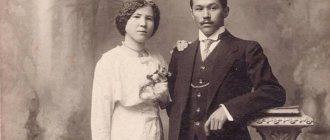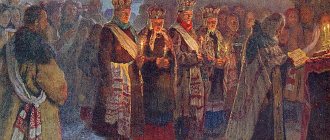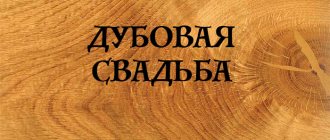Mysteries of the Chuvash people
Chuvash wedding rituals are closely interconnected with everyday and religious legends. Everyday customs include bride price and dowry. Religious legends make it possible to save a family from evil spirits and the evil eye, as well as attract happiness and wealth.
The entire wedding process lasts for several weeks and is based on many steps from meeting the newlyweds to marriage.
Dating young people
To find his beloved, the groom had to travel beyond the borders of his native area. This gave confidence that the future wife would not be in a family relationship with the chosen one. Residents of the same village could be relatives to each other. And according to the rules, it is strictly forbidden to marry a girl from your inner circle.
For the same reason, many settlements took part in the celebration, where young people got to know each other. There were also cases where the father and mother chose the groom’s couple. But they always consulted with both the boy and the girl before entering into marriage. If there is sympathy between the parties, it is necessary to give gifts. Women are presented with scarves, and men are presented with various treats.
Choosing a future spouse
After the groom has chosen his betrothed, he talks about his answer to his family. Before the wedding celebration, father and mother must make sure that a healthy and well-mannered woman is invited to the home. Since the future wife will be the mistress of the house, she must keep order. The girl’s skills were carefully checked by her relatives. Mature women are valued more, as they have a substantial dowry and experience in housekeeping.
Matchmaking process
Most often, matchmaking takes place in the spring. Matchmakers are sent to the future wife. The team includes numerous relatives and close family members. But there is a distinctive feature - the number of matchmakers is always odd. Residents who have been chosen appear at the girl’s home with treats and drinks. If the parents make the choice, then the groom is taken to the first reception. If a man does not appreciate a woman, then the young man can calmly refuse her. Then the matchmaking process begins again.
After arriving at the bride's house, the groom's relatives start a usual conversation with the girl's parents. This is done consciously, as tradition requires. If the first visit went well, then a second meeting with the future spouses was scheduled.
Some moments of matchmaking
If the matchmakers discussed all the points with the bride’s relatives, then after 2-5 days the future wife’s side came for a visit. Such a meeting made it possible to consolidate acquaintance and conclude an agreement on bridewealth and dowry. Both sides exchange treats. The bride must present gifts to her chosen one's relatives.
Negotiations about a future event take place at the table. The wedding day was scheduled after 3 or 5 weeks. The main requirement is that the holiday is held on an odd week.
The dowry includes kitchen utensils, clothing and livestock. Kalym consisted not only of money, but also of food for celebration. Such customs of the Chuvash people are still used today. Only now everything is defined in monetary values.
The giving of the bride price takes place a few days before the event. The bride's relatives place bread and salt on the table, and the groom's relatives cover it with a bag of money. The girl's father or grandfather takes the bride price, and gives the bag with the enclosed coin back. This custom is necessary to ensure that the house never runs out of money.
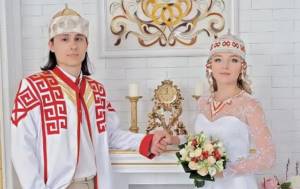
Chuvash wedding traditions and rituals
The wedding traditions of the Chuvash people have ancient roots and are dictated both by everyday realities (for example, bride price or dowry, which reimbursed families for wedding expenses and helped young people to settle down financially) and religious beliefs (protection from evil spirits, attracting happiness). The wedding process from matchmaking to the marriage ritual took several weeks. It was performed in a certain order, which was supervised by a specially selected man from the groom’s relatives.
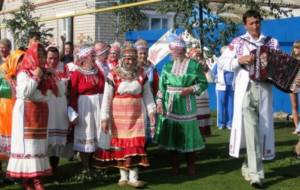
Dating and choosing a bride and groom
It was customary for the Chuvash to go farther from their native village in search of their soulmate. It was better if the girl lived in neighboring and distant settlements, so as not to accidentally choose one of her relatives as a wife. Residents of one village could be closely or distantly related, and according to Chuvash traditions, marrying relatives up to the seventh generation is prohibited.
In this regard, holidays common to several villages were commonplace - and, as a rule, acquaintances between Chuvash youth took place there. Sometimes the parents were in charge of choosing the bride/groom, but according to tradition, it was customary to ask the newlyweds for consent before the wedding. The girl’s expression of sympathy was expressed by donating a hand-embroidered scarf to her chosen one, and the guy treated his beloved with gifts.
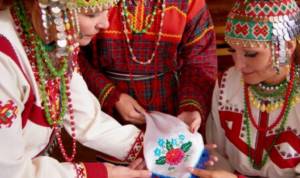
Having chosen his betrothed, the future groom announced this to his parents, who had to make sure before the wedding that they were taking into their family a healthy, well-educated girl. Since the future wife was supposed to become a full-time worker in her husband’s house, her hard work and housekeeping skills were assessed especially carefully. Mature brides among the Chuvash were traditionally considered more valuable than young ones, because... the latter usually have less dowry and management experience.
Matchmaking ritual
The Chuvash consider spring to be the most popular time for matchmaking. According to tradition, matchmakers were sent to the girl: the senior groom (a close relative of the groom who negotiated with the bride’s parents), the younger groom (chosen from among the groom’s young relatives, he was responsible for communicating with the newlywed’s retinue, singing songs at the wedding) and other relatives or close friends. The total number of matchmakers must be odd.
Matchmakers always brought drinks and gifts (the latter in odd quantities). This Chuvash tradition is due to the fact that in fact there is no couple (groom + bride) before matchmaking. If the betrothed was chosen by the parents, the groom was taken to the first matchmaking so that he could take a closer look at the bride and get to know each other. If he didn't like the girl, the guy could refuse the wedding.
Arriving at the bride’s house, the matchmakers sat down in the middle of the hut and began a cunning conversation with the girl’s father, avoiding communicating their intentions. As a rule, it was about selling something. The bride's parents, supporting the Chuvash tradition, replied that they were not selling anything, after which the matchmakers invited the bride herself to a conversation, revealing the purpose of the visit.
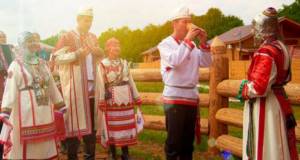
If the matchmakers managed to come to an agreement with the girl’s parents, a few days later the boy’s parents came to the bride with gifts for an acquaintance and a final agreement on the bride price and dowry. The bride's relatives prepared a return meal, and the bride, following tradition, gave towels, shirts and other gifts to future relatives. At this celebration, they agreed on the wedding day - as a rule, three or five (necessarily an odd number) weeks after the matchmaking.
Household utensils, clothing, livestock and poultry were given as a dowry for the wedding. The bride price that the groom had to pay included money, animal skins, and food for the wedding feast. This Chuvash tradition has been preserved to this day, but only money is given as a dowry; its size may not be agreed upon in advance (some people pay a large amount, others a symbolic amount, just to keep the tradition).
The transfer of the monetary dowry always takes place before the wedding in the newlywed's house. Her relatives put bread and salt on the table, and the groom’s father, according to tradition, must put a purse with bride price on the loaf. The girl’s father or, if there is no father, senior relatives, having taken the bride price, always return the wallet with the coin placed in it, so that money is not transferred from future relatives.
Wedding preparations
The Chuvash wedding ceremony included many rituals and traditions, which varied depending on the geographical residence of the Chuvash. Of great importance for the performance of rituals was the way the bride was given away - by kidnapping (when the girl was forcibly taken to the groom's house) or by consent. A Chuvash wedding traditionally begins simultaneously in the homes of the couple, then the groom goes to his betrothed’s house, picks her up, takes her to his place, where the holiday ends.
2-3 days before the wedding, the newlyweds (each in their own village), together with friends and family, visited all relatives. Beer for a wedding was also traditionally brewed in advance. A Chuvash wedding began with cleaning and a bath for the newlyweds and their relatives. After the usual bath for cleanliness, the newlywed was given another one - for the ritual of cleansing from evil spirits. Then the young people dressed in new clothes, asked the old people to bless the wedding, after which all ceremonies and rituals began.
Chuvash folk song-lamentation
In some ethnic groups of the Chuvash (lower, middle lower), the ritual of the bride's weeping was necessarily performed at a wedding. This tradition has been preserved in some places to this day. On the wedding day, before finally leaving her parents' home to go to her betrothed, the Chuvash girl had to sing a sad lamentation song with lamentations about how she did not want to leave her home for someone else's, to break away from her family.
According to tradition, the married sister (or relative) began to lament first, showing the young one how to do it. Then the newlywed would pick it up and tearfully wail at the top of her voice, remembering her parents, brothers, sisters, childhood, and native places. Each Chuvash bride composed the song in her own way. Continuing to howl inconsolably, the girl hugged all her relatives, friends and fellow villagers one by one, as if saying goodbye.
While crying, the newlywed gave the person who came up a ladle of beer, where he was supposed to put the coins. According to the Chuvash tradition, this money was called “tribute of lament” (or “vytny money”), later the young woman put it in her bosom. The ritual of crying continued for several hours until the girl was taken to her betrothed. It is noteworthy that while the newlywed was crying, those gathered in the hut had to dance and clap, trying to amuse the young woman.
Wedding at the bride's house
While the guests were gathering in the house, praying for the well-being of the newlyweds, preparing food and waiting for the groom's train, the young woman and her friends were dressing up in a separate room. It was not customary to let the entire groom’s procession into the bride’s house at once. According to Chuvash tradition, the groomsmen first had to pay the newlywed's father a symbolic fee (not bride price). After this, the guests were allowed inside, the young man was given beer and seated in a special place, where the girl’s parents put money, and the guy took it for himself.
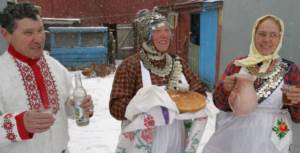
The feast began, the guests had fun, danced, then brought out the bride, covered with a wedding veil. The girl began to sing a traditional Chuvash lament song with lamentations, after which she was taken to her betrothed’s house. When leaving the outskirts, the groom performed a ritual of expelling evil spirits - he hit his betrothed three times with a whip. The wedding train was returning with songs and music.
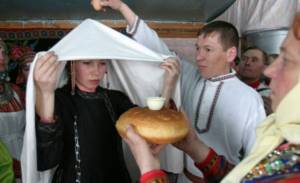
Wedding at the groom's house
While the guests (relatives, friends, fellow villagers of the groom) were gathering, the future husband was dressed in a Chuvash wedding suit by close relatives. Then the newlywed went out into the courtyard with the guests, where the first dances with songs began (the groomsmen and bachelor boys danced). After the dance, everyone went into the house and treated themselves to drinks. The groom's groomsmen and the bachelors danced again, everyone had fun, and then went to the house of the future wife. Such a train, led by the groom, was traditionally accompanied all the way by music and songs.
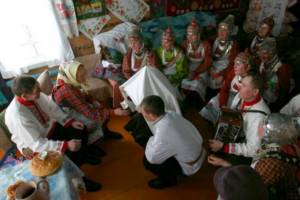
The newlyweds usually returned from home in the evening. Following the Chuvash ritual, the bride was sent to sleep with the groom's relatives; all participants in the ceremony and relatives of the newlywed stayed in his house to spend the night. The next morning the wedding ceremony took place in the church. After the wedding, everyone returned to the house, took off the wedding veil from the bride, then, according to tradition, dressed her in the clothes of a married woman, and the wedding continued.
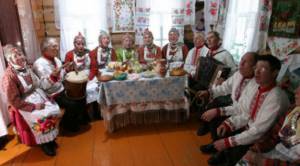
After the wedding, many different Chuvash rituals were performed. So, at the father-in-law’s gate, a raw egg was broken near the newlyweds. At the husband's house, the couple was always fed runny scrambled eggs with milk - this wedding tradition symbolized a happy family life. All significant ceremonies ended with the escort of the newlyweds to the marriage bed: the couple was simply locked in a room for an hour or two, then their daughter-in-law (or matchmaker) lifted them up.
After the newlyweds had been to the marriage bed, the newly-made wife was traditionally sent to fetch water. The young woman had to collect a bucket of water from any source and bring it to the house. At the same time, the sister-in-law kicked the full bucket three times, and the young woman had to fill it up again, only on the fourth time she was allowed to carry away the water. After all the rituals were completed, the guests feasted for another day - this was the end of the Chuvash wedding.
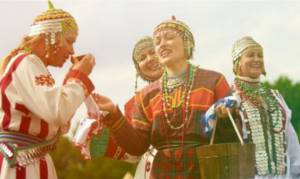
Post-wedding customs
For the first three days after the wedding, the newly-made wife is not allowed to clean. Close relatives do this, and the young woman gives them small gifts for this. After the wedding, the newlywed must give gifts to her mother-in-law seven times. In the first year after the wedding day, according to Chuvash tradition, related families go to visit each other. This strengthens family ties.
A week after the wedding, the newlyweds and their parents had to visit their father-in-law. Three weeks later we went to see our father-in-law again, but this time with our parents and one of our relatives. Six months later, 12 people (with the parents of the newly-made husband and relatives) went to the father-in-law’s house; this visit lasted three days, and the young family received the rest of the dowry (livestock).
Another Chuvash tradition prohibits newlyweds from singing and dancing at the wedding ceremony. It was believed that if the groom sang songs or danced at his wedding, it would be difficult for the young wife to live in marriage. The newlyweds could have fun for the first time only on the first visit after the wedding day to their father-in-law. But modern Chuvash newlyweds often break this tradition by performing the first wedding dance immediately after the ceremony.
Preparation for the celebration
Numerous Chuvash wedding customs differ from the geographical location of the people. The ritual is also influenced by the consent of the future wife to her theft.
The event begins to take place in two houses at once. Then the groom takes the bride to his house, where the celebration continues.
2-4 days before the event, the young couple visits all relatives and friends in the settlement. There is another tradition - brewing. The first step is to clean the sauna area. After this, the bride undergoes a second bath, which allows her to be cleansed of evil spirits. After the bath, the newlyweds put on traditional costumes and ask their parents for blessings. Then the solemn ceremony begins.
Dressing the Groom
The groom was dressed in the evening in a cage where there was a table and chairs, food and drink. The groom was dressed in new and clean linen. His sister-in-law cut his hair and dressed him.
A caftan or robe is used as outerwear. The caftan is belted with a large green or blue sash. A kind of short scarf or towel is hung from the back of the caftan on the belt. Cooked during matchmaking by the bride so that the parts embroidered or woven at the ends with beautiful patterns hang down near the pockets. It is called kẽtutri or kẽsurpanẽ.
A Ģulăk was attached to the back, which was a small white embroidered scarf folded into a triangle with silk fringes. The sleeve was sewn to the shoulders at two ends, and the third corner behind the back.
A large sheepskin or fur hat was placed on the head; Coins were hung on the hat near the forehead.
Large leather mittens or gloves were put on the groom's hands. In addition, the young man always held a whip - salamat.
The groom did not take off all the equipment with the listed attributes, either in the house or at the table, throughout the wedding. The idea of the groom has always been inextricably linked with his visible ritual clothing.
The beginning of the celebration
The invited guests are in the house waiting for the groom. Relatives are engaged in preparatory activities. Treats are placed on the table. After which close people read a prayer for the well-being of the young family.
At the same time, in another room, the bride and her bridesmaids are trying on a wedding dress. After the groom arrives, he pays the girl's father money in the form of a symbolic fee. Then the event takes place in the house. The groom takes the place where the girl’s parents indicate.
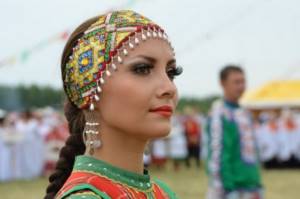
Meeting your future spouse at a holiday
When a cheerful feast with songs and dances takes place, the newlywed is introduced. It must be under the wedding veil. The bride starts a song with lamentations. After this, the man takes her to his home. During the trip home, the groom must perform a ritual that will protect his family from evil spirits. It consists of whipping the wife with a whip about 3-5 times. The return journey is accompanied by music.
Preparatory activities at the groom's house
When guests gather at the home of the future spouse, he is dressed in a traditional Chuvash costume. Then the man goes out into the yard, where single guys sing songs. Once the first stage is completed, everyone returns to the house and starts drinking. Then the groom goes to get his wife.
They return to the groom's house only in the evening. The wife and the groom's relatives remain in the graveyard in the man's house. In the morning, the next ritual is performed - a wedding in the church. After the ceremony, the invited guests and newlyweds return home. There they already change into the outfit of a married girl and the wedding feast continues.
Ceremonial event at the groom's home
The rituals after the wedding do not end there. Near the outskirts of the bride's father, an egg breaks. The husband eats the liquid substance and washes it down with milk. This tradition promotes happiness in family life. After each ceremony, the newlyweds go to the marriage bed. The newlyweds are locked in a room for 2-6 hours, after which one of the mothers lets them out.
According to tradition, after the wedding night, the woman goes to fetch water. The wife must bring a filled bucket, while her sister-in-law prevents her from doing this 3 times. Only 4 times is it allowed to bring water into the house. After the wedding, the festivities continue for several more days.
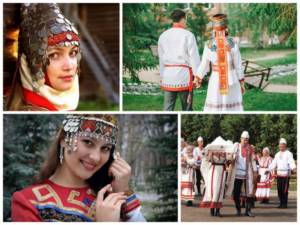
National traditions
A Chuvash wedding is associated with everyday and religious beliefs. Household ones include bride price, dowry, religious ones include protection from evil spirits and attracting happiness in a new family. The entire wedding ceremony lasts for several weeks and goes through many stages from matchmaking to marriage.
Dating and choosing a bride and groom
In search of his beloved, the groom had to go far beyond the borders of his native village. This created confidence that the girl would not be closely related to her chosen one. Residents of one village or village could be relatives, which is strictly prohibited according to the canons of Chuvash traditions.
For this reason, several settlements took part in the holidays, where young people met. There are cases when the other half is chosen by the parents, but in this case the consent of both parties must be sought before the marriage. When sympathy arose among one of the parties, according to national tradition, it is customary to give gifts, the girl presents a scarf, and the guy treats him with gifts.
Bride's choice
After choosing a betrothed, the young man announced his decision to his parents, the father and mother, in turn, before the wedding, made sure that they were taking a healthy and well-mannered girl into the house. Since the future wife becomes the full-fledged mistress of the house and is directly obliged to keep order, the worker’s skills were checked with special care. More mature brides are valued more than very young ones, and the dowry is more substantial and they have experience in housekeeping.
Traditions after the wedding to strengthen family life
After marriage, the newlyweds do not have the right to clean up the house for another 3 days. Relatives did this, for which the wife paid them off with gifts. Also, the groom's mother presented the family with various treats and gifts. The first year after the wedding, relatives visit each other. This allows family ties to be fully consolidated.
After 7 days, the newlyweds visit their father-in-law. After another 3-5 days, the bride’s father is visited again, but this time together with the husband’s parents. After 6 months, 12 relatives visit the father-in-law. Everyone stays for 3 days. During this period, the remainder of the dowry is returned.
Another belief is that the groom should not dance at his own celebration. If the rule is not followed, it means that life in marriage will be bad. Rest is allowed only after the groom's first visit to his father-in-law. But modern young couples are allowed to perform the first wedding dance right at the ceremony.
A wedding is the main stage in the life of a Chuvash.
For the Chuvash population, a wedding is as significant a moment in life as death or birth; it is a symbolic life stage—the creation of a social unit for the family tree. Since ancient times, the Chuvash have considered creating a family to be the life goal of every person. If a person, for some reason, did not have time to get married and did not have children, he dies in sin. Preparing and holding a Chuvash folk wedding is not just an ordinary holiday with a feast, it is a stage in life with the observance of rituals.
On the topic of the article: features of an Orthodox wedding
Traditional costumes of the Chuvash people
The groom wears an embroidered shirt and caftan for a wedding event. He girds everything with a blue or green sash. Mandatory paraphernalia includes boots, gloves, a fur hat with a coin on the forehead, and neck jewelry. During the matchmaking period, the bride is given an embroidered scarf. The husband sews it to his belt at the back, and holds the whip in his hands. Even if the weather is hot, the groom cannot remove anything from the presented paraphernalia.
The bride dresses in a dress with up to 15 kg of jewelry, 2-3 kg of which are silver coins. They are attached to a headdress and a cape ribbon. The future wife's outfit consists of a shirt, apron, robe or caftan. According to customs, they are also decorated with embroidery. Customs also include wearing rings, bracelets, neck and chest pendants. The future wife takes a wallet and a mirror with her. The bride's headdress is decorated with beads, shells and coins. The designs on the suit resemble geometric shapes. Each of them contains meaning. The newlywed is covered with thick white fabric with embroidery.
A Chuvash wedding is quite unusual. But by observing all the customs and following all the steps clearly, the family will live happily and richly.
Traditional marriage rituals
Wedding celebrations were traditionally scheduled in the fall. After the end of the harvest season, the best time came for a walk with the whole world, and with all the breadth of the soul. The bins were bursting with fresh fruits and vegetables, and the new wine was ripening, and the main hard work in the fields was over.
A wedding in Moldova was never hastily planned. A year, or even more, passed from the young couple's meeting to the wedding day. All this time, preparations were being made for the grandiose action and the subsequent feast. Every little detail was scrupulously taken into account, and the wedding date was chosen with all care: it should not fall on fasting or unfavorable days. Wedding witnesses and nashaul advisers were selected. They could only be a strong married couple, older than the newlyweds, but younger than their parents, who would help the newlyweds during the celebrations, and then begin to give wise advice in family life.
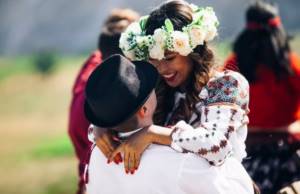
Matchmaking and engagement
The ancient traditions of a Moldovan wedding involve a mandatory matchmaking ritual. For this purpose, favorable days were always chosen - Thursday, Saturday or Sunday, but not on major church holidays or on days of fasting. Matchmakers were sent to the chosen girl's house, and the presence of the groom was not required. They described in colorful terms all the advantages of the young successful hunter who had spotted such a desired prey. In allegorical speeches and careful observance of the time-honored ritual, there is a sacred meaning: only in this way will the future family be protected from misfortunes.
If the girl’s parents gave preliminary consent to the marriage, then her personal belongings were handed over to the groom or his representative. Then followed a heated bargaining between both parties, when a ransom, sometimes quite serious, was demanded for the bride. Once the parties reached an agreement, a date for final agreement was set. This time, usually up to two weeks, was given to think and weigh all the pros and cons. At the end of this period, the agreement could either be confirmed or terminated without mutual claims. After this, an engagement was scheduled. Usually the preparation for it lasted about seven to ten days.
On this day, the bride's relatives paid a return visit to the groom's house, making sure that everything said about him by the matchmakers was true. And a young hunter is a truly worthy choice; he is a strong owner with skillful hands and will be able to adequately support his family. Hospitable hosts served a rich feast, and a leisurely conversation began. They discussed the details of future wedding celebrations, the list of guests, the day and the bride's dowry were set.
Considerable disputes often flared up over the size of the dowry. Usually the girl was given luxurious hand-embroidered carpets and carpet runners for the floor, embroidered towels and linen, and kitchen utensils. The boy’s parents, for their part, allocated a plot of land, materials for building a house, a work horse and tools.

Preparation period
The selection of nashauls was approached with great care. Not every couple was suitable for such a responsible role. And without their presence, the wedding could not have taken place at all - this is as indisputable an element of a Moldovan wedding as the newlyweds. The chosen married couple had to have family ties with the newlyweds and be happily married. Also, an important criterion was their strong financial situation and willingness to help and mentor the young family.
Invitation cards were baked goods lovingly baked by the hands of the young housewife - bagels, rolls or gingerbread. Ignoring an invitation was considered a serious insult, so such a responsible mission was not refused without a serious reason. In essence, these people became second parents for the newlyweds.
Nowadays, good acquaintances, friends of parents, or married couples from among the newlyweds’ peers are invited to play the role of nashauls. After this, an application for marriage registration is submitted to the registry office, a banquet hall is selected and booked if the wedding is planned to be held in a restaurant, and the holiday scenario is specified.
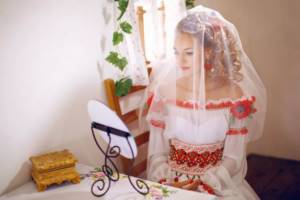
Traditional robes and modern outfits
National wedding costumes of Moldovans are masterpieces, hand-embroidered with amazing patterns. Making them takes a lot of time and effort, but it is worth it - no store-bought dress can compare with the exquisite simplicity and amazing patterns of folk wedding vestments. Silk, dyed cotton threads, beads, and beads are used for embroidery. The base is white, onto which red, black and blue patterns are sewn. Shirts, sashes and trousers are sewn for the groom, the dress for the bride must be embroidered along the hem, collar and sleeves, and an embroidered apron and belt are tied.
Choosing a bride and meeting the groom
Like many peoples, Chuvash traditions do not allow choosing a person from among relatives up to the seventh generation as a wife or husband. Marriages were allowed from the eighth generation. The ban, of course, is connected with ensuring that all conditions for the birth of healthy offspring are met.
Among the Chuvash it was often the case that the inhabitants of one village descended from one ancestor.
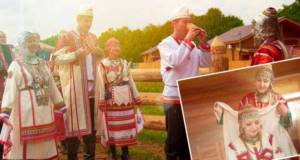
Therefore, young Chuvash grooms looked for future wives in neighboring and more distant settlements.
So that young people had the opportunity to get to know each other, gatherings were often held with all kinds of games, holidays and communication between representatives of several villages from the area. Another option for finding a wife or husband is general work in the field, for example, haymaking.
As in other nationalities, if a young Chuvash guy spoke about his intention to get married, then his parents, first of all, began to find out about the bride. What family is she from, what is her health, what kind of housewife is she. Isn't she lazy, what kind of intelligence and character, and the girl's appearance mattered.
It happened that the bride was somewhat older than the groom. The age difference could be up to 10 years. This is explained by the fact that the groom’s parents tried to get him married faster so that there would be additional hands in the house. And the bride’s parents, on the contrary, tried to keep their daughter near them longer, for the same reasons.

In the Chuvash tradition, it was generally accepted that the older the bride, the more valuable she was, since she was more skilled and, as a rule, had a richer dowry. Chuvash brides began preparing dowries from childhood.
It happened that parents themselves chose future spouses for their children, but the consent of the children themselves, of course, was necessary.
Khaimatlăkh (imprisoned father)
The imprisoned father protected the groom. He was a trusted person who was entrusted with delivering the bride safe and sound.
Khaimatlăkh and khaimatlăkh arămĕ (the wife of the imprisoned father) were inseparably with the girl. We rode in the same cart during the move. Were with her when leaving and entering any room.
During songs and dances, she distributed shirts to her parents, older and younger brothers and, having accepted their blessing, left with her husband on the cart of her imprisoned father.
At the same time, the haymatlăkh carried the bride out of her parents’ house and placed her in the cart in his arms.
A person from the guy's relatives or a close friend of his family was chosen as the imprisoned father.
Features of national costumes of different ethnic groups
Among the Chuvash, there are two ethnic groups based on their residence relative to the Volga: the upper (viryal) and the lower (anatri). Between them are the middle-lower Chuvash (Anat-Enchi), their dialect is closer to the Viryaly, and the details of their costume are closer to the Anatri.
Anatri
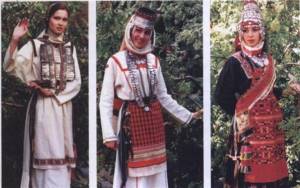
The Anatri borrowed a lot from the Tatar peoples. In the embroidery, the main color is red, and the large geometric pattern turns into a floral one. In the 19th century, Anatri borrowed aniline dyes for fabric from merchants. Everyday clothes became multi-colored, called motley. Striped and checkered woven patterns are common. Festive and ritual attire remained white. The tukhya cap is pointed, like a military helmet, with earmuffs, beadwork and a large number of silver coins. The surpan of a married woman, anathri, is very large - up to 2.5 m. It was decorated with braid, ribbons, lace, and of course, embroidery. It was secured with a pus tutri bandage.
Anat-enchi
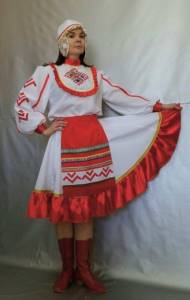
Anat-enchi's patterns are dominated by bright colors of light green, yellow, and red, and there are both geometric and floral patterns. Motley also became their favorite clothing. Tukhya anat-enchi is very similar to the anatri cap, but without the sharp tip on the top. Surpan - narrower and shorter than that of anatri, was decorated with calico, embroidery and lace. It was secured with a masmak bandage.
Virial
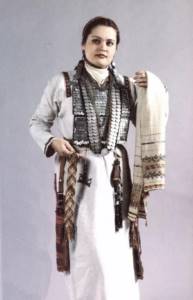
The Viryal traditions are closer to the Finno-Ugric ones, since they were in territorial contact with the mountain Mari. The embroidery patterns use geometric patterns and dark tones of green, blue and red. Viryal did not accept the motley crew and even physically punished the fashionistas. Tukhya viryal is richly embroidered, but there is much less silver on it than on its more southern neighbors. Surpan, compared to the previous ones, was small (only 1.2-1.5 m) and narrow. Its decoration was double-sided embroidery with a geometric pattern, beads and fringe. Masmak - in the form of a narrow strip of colored fabric embroidered with symbols of the creation of the world.
Customs of other countries
The most interesting wedding traditions of other countries:
- ritual of tears (China). Thirty days before the wedding, the bride begins to cry; She usually cries for an hour a day. Ten days later, her mother joins the girl, and ten days later, her grandmother joins her. Such tears are not considered sad, but bring joy and love. Since all representatives of the fair sex cry in a different key, together their crying begins to sound like a song;
- kissing tradition (Sweden). During the wedding celebration, the groom suddenly disappears somewhere, and at this time all unmarried young people are allowed to kiss the bride. The situation is exactly the same with girls: if the bride goes somewhere, she thereby gives them the opportunity to kiss the groom;
- spitting on the bride (Kenya). This is the name of the oldest wedding ritual of the Maasai tribe. During the festive celebration, guests apply oil and sheep fat to the bride's head. The father, blessing his daughter, spits on her head and chest. These people believe that such actions help to attract good luck and happiness;
- marry a tree (India). Some women in this country are considered cursed and called "Mangliks". This word comes from an astrological combination: Mars and Saturn are in the seventh house. In this situation, marrying a man will lead to his imminent death. To protect herself from the curse, the girl first marries a tree, which must be cut down after the procedure;
- with a stick on the heels (Korea). At the end of the wedding festivities, the groom takes off his shoes, binds his feet and begins to beat his heels with a stick. There is a legend that this is supposed to give a man strength before his wedding night. During the test, the groom is asked various tricky questions. The event is of an entertaining nature: no one seeks to hurt the man;
- black bride (Scotland). To representatives of other states, such a custom must seem absolutely wild: a girl about to get married is sprinkled with the most disgusting products, and after that she is also tied to a tree in front of everyone. The range of ingredients for the ritual may include: sauces, flour, sour milk and even fish. The Scots believe that if a lady copes with such a test, she will not be afraid of any difficulties of family life;
- sawing logs (Germany). This tradition was invented in order to test how well a married couple can work together. Sawing one log for two shows the newlyweds’ ability to cope with the difficulties of future family life;
- fattening the bride (Mauritius). In the generally accepted view, all girls strive to lose weight before the wedding in order to fit into the elegant dress they purchased. Mauritanian ladies act exactly the opposite: they want to gain as much weight as possible before such a significant event. Curvy shapes speak of the wealth of the bride's parents;
- keep everything to yourself (Indonesia). After the wedding ceremony, the newlyweds are prohibited from leaving the house or using the toilet for three days. During this period, the couple is given a minimal amount of food and water. People believe that this custom promotes a happy marriage and healthy babies;
- bride kidnapping (Romania). This tradition is quite popular and also exists in some countries in Asia and Africa. If a man, through persuasion or deception, manages to kidnap and keep a girl in his house for several days, she will be officially declared his wife.
